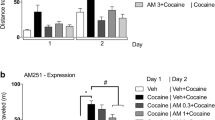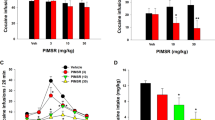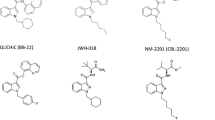Abstract
Rationale. Marijuana is known to have psychotropic effects in humans. In this study, we used rat models of sensorimotor gating, hyperactivity and stereotypy to explore whether CB1 receptor stimulation or blockade induces behavioral changes consistent with psychotomimetic or antipsychotic agents, respectively.
Objectives. We determined whether (a) the cannabinoid agonist CP 55940 decreased pre-pulse inhibition (PPI) as might be expected from a psychotomimetic agent, and (b) the selective CB1 receptor antagonist, SR 141716A, had any effect on PPI on its own or following disruptions by psychotomimetic agents. In addition, we investigated the effects of SR 141716A on elevated levels of hyperactivity and stereotypy elicited by d-amphetamine.
Methods. These studies were conducted in rats using standard methodologies for determination of PPI following acoustic stimuli, and d-amphetamine-induced hyperactivity and stereotypies.
Results. Decreased startle responses to 120 dB stimuli were observed in rats treated with CP 55940 (0.1 mg/kg IP) in the absence and presence of a 73 dB pre-pulse. These effects were reversed by SR 141716A (5 and 10 mg/kg, respectively). SR 141716A (0.1, 5, 10 mg/kg) had no effect on PPI on its own or following disruptions by apomorphine, d-amphetamine or MK-801. Conversely, in separate experiments different antipsychotic agents reversed disruptions in PPI induced by d-amphetamine (haloperidol), apomorphine (haloperidol or clozapine) or MK-801 (clozapine or olanzapine). In addition, unlike haloperidol, SR 141716A (5 mg/kg) did not reverse d-amphetamine-mediated increases in hyperactivity or stereotypy.
Conclusions. The CP 55940-mediated decreases in startle amplitude confound assessment of the effects of CB1 receptor activation on PPI. The failure of SR 141716A to reverse disruptions in PPI, hyperactivity or stereotypy induced by non-cannabinoid psychotomimetic agents suggests that blockade of the CB1 receptor on its own is not sufficient for antipsychotic therapy.
Similar content being viewed by others
Author information
Authors and Affiliations
Additional information
Electronic Publication
Rights and permissions
About this article
Cite this article
Martin, R.S., Secchi, R.L., Sung, E. et al. Effects of cannabinoid receptor ligands on psychosis-relevant behavior models in the rat. Psychopharmacology 165, 128–135 (2003). https://doi.org/10.1007/s00213-002-1240-x
Received:
Accepted:
Issue Date:
DOI: https://doi.org/10.1007/s00213-002-1240-x




